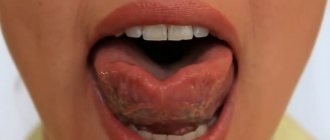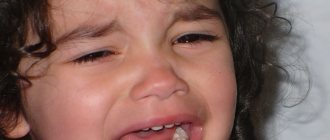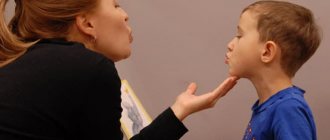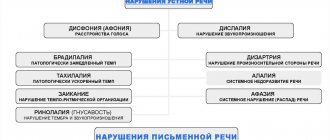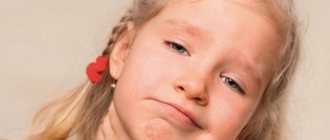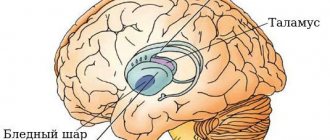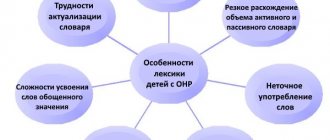Dysarthria
The speech of patients with dysarthria is slurred, unclear, and incomprehensible (“porridge in the mouth”), which is due to insufficient innervation of the muscles of the lips, tongue, soft palate, vocal folds, larynx, and respiratory muscles. Therefore, with dysarthria, a whole complex of speech and non-speech disorders develops, which constitute the essence of the defect.
Impaired articulatory motor skills in patients with dysarthria may manifest as spasticity, hypotonia, or dystonia of the articulatory muscles. Muscle spasticity is accompanied by constant increased tone and tension in the muscles of the lips, tongue, face, and neck; tightly closed lips, limiting articulatory movements. With muscle hypotonia, the tongue is flaccid and lies motionless on the floor of the mouth; the lips do not close, the mouth is half open, hypersalivation (salivation) is pronounced; Due to paresis of the soft palate, a nasal tone of voice appears (nasalization). In the case of dysarthria occurring with muscular dystonia, when attempting to speak, muscle tone changes from low to increased.
Sound pronunciation disturbances in dysarthria can be expressed to varying degrees, depending on the location and severity of damage to the nervous system. With erased dysarthria, individual phonetic defects (sound distortions) and “blurred” speech are observed.” With more pronounced degrees of dysarthria, there are distortions, omissions, and substitutions of sounds; speech becomes slow, inexpressive, slurred. General speech activity is noticeably reduced. In the most severe cases, with complete paralysis of the speech motor muscles, motor speech becomes impossible.
Specific features of impaired sound pronunciation in dysarthria are the persistence of defects and the difficulty of overcoming them, as well as the need for a longer period of automation of sounds. With dysarthria, the articulation of almost all speech sounds, including vowels, is impaired. Dysarthria is characterized by interdental and lateral pronunciation of hissing and whistling sounds; voicing defects, palatalization (softening) of hard consonants.
Due to insufficient innervation of the speech muscles during dysarthria, speech breathing is disrupted: exhalation is shortened, breathing at the time of speech becomes rapid and intermittent. Voice disturbances in dysarthria are characterized by insufficient strength (quiet, weak, fading voice), changes in timbre (deafness, nasalization), and melodic-intonation disorders (monotony, absence or inexpressibility of voice modulations).
Bulbar dysarthria
Bulbar dysarthria is characterized by areflexia, amymia, disorder of sucking, swallowing solid and liquid food, chewing, hypersalivation caused by atony of the muscles of the oral cavity. The articulation of sounds is slurred and extremely simplified. All the variety of consonants is reduced into a single fricative sound; sounds are not differentiated from each other. Nasalization of voice timbre, dysphonia or aphonia is typical.
Pseudobulbar dysarthria
With pseudobulbar dysarthria, the nature of the disorder is determined by spastic paralysis and muscle hypertonicity. Pseudobulbar paralysis manifests itself most clearly in impaired tongue movements: great difficulty is caused by attempts to raise the tip of the tongue upward, move it to the sides, or hold it in a certain position. With pseudobulbar dysarthria, switching from one articulatory posture to another is difficult. Typically selective impairment of voluntary movements, synkinesis (conjugal movements); profuse salivation, increased pharyngeal reflex, choking, dysphagia. The speech of patients with pseudobulbar dysarthria is blurred, slurred, and has a nasal tint; the normative reproduction of sonors, whistling and hissing, is grossly violated.
Subcortical dysarthria
Subcortical dysarthria is characterized by the presence of hyperkinesis - involuntary violent muscle movements, including facial and articulatory ones. Hyperkinesis can occur at rest, but usually intensifies when attempting to speak, causing articulatory spasm. There is a violation of the timbre and strength of the voice, the prosodic aspect of speech; Sometimes patients emit involuntary guttural screams.
With subcortical dysarthria, the tempo of speech may be disrupted, such as bradyllalia, tachylalia, or speech dysrhythmia (organic stuttering). Subcortical dysarthria is often combined with pseudobulbar, bulbar and cerebellar forms.
Cerebellar dysarthria
A typical manifestation of cerebellar dysarthria is a violation of the coordination of the speech process, which results in tremor of the tongue, jerky, scanned speech, and occasional cries. Speech is slow and slurred; The pronunciation of front-lingual and labial sounds is most affected. With cerebellar dysarthria, ataxia is observed (unsteadiness of gait, imbalance, clumsiness of movements).
Cortical dysarthria
Cortical dysarthria in its speech manifestations resembles motor aphasia and is characterized by a violation of voluntary articulatory motor skills. There are no disorders of speech breathing, voice, or prosody in cortical dysarthria. Taking into account the localization of lesions, kinesthetic postcentral cortical dysarthria (afferent cortical dysarthria) and kinetic premotor cortical dysarthria (efferent cortical dysarthria) are distinguished. However, with cortical dysarthria there is only articulatory apraxia, while with motor aphasia not only the articulation of sounds suffers, but also reading, writing, understanding speech, and using language.
Article:
The article is an approbation of a final qualifying work on the topic: Speech therapy work to overcome articulatory motor disorders in children with dysarthria.
Researchers like O.V. Pravdina, O.A. Tokareva, I.I. Panchenko, R.I. Martynova, L.V. Lopatina, A.V. Serebryakova, M.V. Ippolitova, E.M. Mastyukova, E.F. Arkhipova, M.B. Eidinova and others made a great contribution to the study of the problem of symptoms and structure of speech defects that occur with dysarthria.
Dysarthria, as a speech disorder, leads to impaired articulatory motor skills due to limited mobility of the muscles of the speech apparatus, due to the fact that the innervation of the speech apparatus is impaired, which in turn disrupts the pronunciation aspect of speech.
Damage to the formation of the movement of the speech apparatus leads to a disorder of sound pronunciation, which creates problems in mastering the school curriculum in the future, since the phonetic-phonemic and lexical-grammatical aspects of speech suffer, which are difficult to correct.
Due to the fact that the child cannot fully pronounce sounds correctly, his speech becomes difficult to understand, which in turn leads to complexities and difficulty communicating with peers and adults, as well as aggression and pessimism.
Everyday speech therapy correction allows you to shape the development of articulatory motor skills. However, at present, the problem of providing comprehensive assistance to children with this speech disorder in mass children's institutions is insufficient. The problem of studying the specifics of the development of articulatory motor skills, which was studied by such researchers as E.F. Arkhipova, E.N. Vinarskaya, L.S., still remains relevant. Volkova, O. V. Pravdina, L. V. Lopatina and others.
As part of the final qualifying work on the topic: “Speech therapy work to overcome articulatory motor disorders in children with dysarthria,” a selection of research materials on this problem was carried out, 30 preschool children of older groups attending a mass kindergarten were examined.
The object of the study was the characteristics of articulatory motor skills of children of senior preschool age with dysarthria.
The subject of the study of the final qualifying work was the formation of articulatory motor skills in children of senior preschool age with dysarthria.
The purpose of the study is to develop a project for the development of articulatory motor skills.
Tasks that stand out from the goal:
1. Theoretically study special speech therapy literature devoted to the problem of studying the development of the motor sphere in children with dysarthria.
2. Theoretically study and select special methods for diagnosing the level of development of articulatory motor skills in children with dysarthria, conduct an examination and analyze the results.
3. Develop a project for the development of articulatory motor skills in older preschool children with dysarthria.
Research stages:
1. Tentative search: selection and analysis of literature on the research topic, drawing up a work plan.
2. Diagnostic: selection of diagnostic methods for the research problem, determination of the research base, control and experimental groups, conducting a confirmatory experiment, analysis of the results obtained.
3. Project: selection of principles, methodological basis of the project, correctional techniques, speech therapy games and exercises, development and writing of the project.
To assess the state of articulatory motor skills in children with dysarthria, methods proposed by E.F. were used. Arkhipova[1].
When studying the functions of the organs of articulation, an analysis was carried out according to the following positions: - state of muscle tone (hypertonicity, hypotonicity, dystonia);
- the ability to carry out involuntary and voluntary movements (kinetic, kinesthetic apraxia)
- quality of articulatory movements (accuracy, rhythm, amplitude, strength of muscle contraction, time of fixation of the articulatory pattern, quality of movements performed, switchability from one movement to another, etc.).
The examination program for articulatory motor skills included:
— examination of kinesthetic oral (articulatory) praxis;
— examination of kinetic oral praxis;
— examination of dynamic coordination of articulatory movements;
— examination of muscle tone and lip mobility;
- examination of the muscle tone of the tongue and the presence of pathological symptoms.
The assessment of the survey results is reproduced in points. The scoring system for assessing functions makes it possible to assess not only the presence of pathological symptoms, but also the degree of its severity.
During the final qualifying work, 30 children with a mild form of dysarthria were selected, since this form of dysarthria is the most common among preschool children studying in mass educational institutions.
A mild form of dysarthria manifests itself in a violation of the phonetic and prosodic aspects of speech and occurs as a result of minimal organic damage to the central nervous system, namely those brain structures that are responsible for organizing the movements of the organs of articulation [3,4].
In many cases, mild dysarthria is confused with dyslalia. This is explained by the fact that the external manifestations of the disorders are similar, but upon deeper examination by a neurologist, children with a mild form of dysarthria demonstrate neurological symptoms characteristic of this disorder.
Violations of articulatory motor skills in mild forms of dysarthria make it difficult to form the articulatory base of speech, which in turn leads to phonetic underdevelopment of speech.
Impaired motor functions in mild forms of dysarthria negatively affect the formation of phonemic and lexico-grammatical aspects of speech and complicate the process of schooling for children.
Timely correction of speech development disorders is a necessary condition for the psychological readiness of children to study at school and creates the prerequisites for the earliest social adaptation of preschoolers with speech disorders. This is extremely important, since the choice of adequate directions of correctional and speech therapy for a child with dysarthria and the effectiveness of this influence depend on the correct diagnosis [3,4].
The children's medical history reveals unfavorable factors of intrauterine development and birth pathology. In infancy and early childhood, there is a lag behind peers in the motor and psychophysical spheres, speech and non-speech disorders.
Having analyzed the research conducted during the final qualifying work on articulatory motor skills, it was shown that in children with a dysarthric component, the development of the kinesthetic basis of the articulation organs is reduced, and unilateral synkinesis was identified in 60%. Some children experience motor awkwardness, inactivity, stiffness, and slowness of all movements, sometimes with a limitation in the range of movements of one half of the face (in 20%). Others have phenomena of motor hyperactivity, restlessness, a fast pace of movements, a large number of unnecessary movements when performing voluntary and involuntary motor acts (80%).
In 100% of children, violations of kinesthetic oral praxis were identified: children reproduced articulation inaccurately, replaced it, searched for the right articulation for a long time, determined the position of the tip of the tongue with errors, and required stimulating assistance in completing the task.
When examining kinetic oral, 100% of children were found to have disorders that manifested themselves in the fact that the child, even knowing the correct articulatory pattern, experienced difficulties in reproducing and maintaining it: the children needed time to find the articulatory pattern, the duration of holding the pose was only 2-3 seconds , twitching, tremor of the tongue, cooperative movements of the mouth, eyes and eyebrows, and asymmetrical execution of movements were observed.
A study of the dynamic coordination of articulatory movements showed that 60% of children with a mild form of dysarthria had disorders that manifested themselves in the fact that the children experienced difficulties in performing movements in a certain sequence, the number of correctly performed movements was limited to 2-3, the range of movements was insufficient: with the mouth open, the tongue did not reach the upper lip; children quickly got tired and had difficulty switching from one movement to another; children did not have time to perform movements, salivation was observed.
In addition to motor insufficiency, the presence of pathological symptoms was revealed in children, which manifested itself in: hyperkinesis (when performing the “bridge” exercise, the tongue either pulled back or protruded from the mouth, contracting to the left and right sides); synkinesias (friendly movements of the facial muscles were manifested during exercises, when the child was required to open his mouth wide, the eyebrows were raised, the eyes opened wide, and when performing the exercise, the eyebrows “furrowed” and the eyes squinted); asymmetry (when performing the “fence” exercise and raising the upper lip, some children experience lip asymmetry, which was expressed in the fact that one side of the lip was pulled more strongly than the other to the side or upward); salivation: in 40% of subjects; hypertonicity in 80%, hypotonicity in 20%; smoothness of nasolabial folds was observed in 60%.
Next, the total number of children was divided into two groups: experimental and control. Corrective work was carried out with the experimental group according to the method of Arkhipova E.F. [2], which indicated that correctional work to overcome a mild form of dysarthria should be carried out daily and repeatedly - only then will it be effective [1]. Therefore, in addition to the speech therapist, the participants in the speech therapy work were also the group teachers and the children’s parents.
In accordance with the principle of taking into account the leading type of activity, all work was carried out in a playful way. In preschool institutions, the educational process is subject to calendar and thematic planning. In this regard, corrective games and exercises were selected in accordance with the general theme of classes in kindergarten, which allowed speech therapy work to organically fit into educational activities during the school year.
Speech therapy work was based on the following principles :
— the principle of relying on the laws of ontogenetic development;
— development principle;
— the principle of a differentiated approach;
— the principle of accounting for leading activities.
The project was designed for 6 months, during which every week two speech therapy sessions lasting 15-20 minutes were held with children in the afternoon.
Corrective work was divided into 3 stages:
I – Preparatory , duration of which is 1.5 months
The objectives of this stage were:
1) normalization of the tone of articulatory and facial muscles;
2) normalization of motor skills of the organs of the articulatory apparatus and facial muscles.
All exercises at this stage were performed based on visual control and together with the speech therapist: the speech therapist first names the exercise, then demonstrates its implementation, and then performs it together with the children in front of the mirror.
To solve the first problem, speech therapy self-massage of facial and articulatory muscles was carried out, which had the following types: 1- stroking, 2- rubbing, 3- kneading, 4- vibration (continuous), 5- shock techniques (intermittent vibration techniques).
To solve the second problem, differentiated articulation and gymnastics were carried out in a playful way. At this stage, children perform a complex consisting of 20 exercises with a functional load proposed by E. F. Arkhipova [2].
II – Main stage , duration of which is 2.5 months
The objectives of this stage were:
1) develop the basic articulatory patterns (dorsal, cacuminal, alveolar, palatal);
2) differentiate the articulatory patterns of individual groups of sounds (whistling, hissing, sonorant);
3) develop articulatory kinetic and kinesthetic praxis (based on visual control).
Work on the second stage was carried out against the backdrop of the ongoing work of the first stage, but more complex. Articulation exercises are performed based on the visual
control, but the speech therapist no longer showed each exercise to the child as at the previous stage.
For the first task, work was carried out to develop four main articulatory patterns: dorsal (whistles), cacuminal (hissing), alveolar ([l], [r]), palatal ([k], [g], [x]) - a series of sequential movements recommended by Arkhipova E.F. and Krause E.N. [2.5]
III – Final stage , duration of which is 2 months.
Stage III tasks:
1) develop articulatory kinetic and kinesthetic praxis (without relying on visual control).
At the last stage, the acquired motor skills are consolidated and children’s self-control over their own articulatory movements is improved. At this stage, children perform a series of motor static and dynamic exercises that they have already performed at the previous stage. The difference is that at the second stage, all exercises were performed based on visual control. At the third stage, visual control is abandoned when performing a series of exercises. Due to this, the development of articulatory kinetic and kinesthetic sensitivity in children reaches a new level.
A repeated examination of the experimental and control groups showed that the method of correctional work is effective, since in 95% of children in the experimental group the indicators of kinesthetic and kinetic praxis improved. An examination of the dynamic coordination of articulatory movements, muscle tone and lip mobility, as well as muscle tone of the tongue and the presence of pathological symptoms showed an increase in indicators.
Thus, the sooner correction work is started, the higher its result will be. Since a mild form of dysarthria in many children is diagnosed after five years, daily speech therapy work is necessary to eliminate motor disorders in children.
Bibliography:
1. Arkhipova, E. F. Erased dysarthria in children. Series: Higher School - M.:AST, 2007-2008. – 254 s
2. Arkhipova, E.F. Corrective speech therapy work to overcome erased dysarthria. – M.: AST: Astrel, 2008. – 254 p.
3. Babina, G.V. Workshop on the discipline “Speech Therapy” (section “Dysarthria”): Educational manual / G.V. Babina. – M., 2012
4. Belyakova, L.I. Speech therapy. Dysarthria / L.I. Belyakova, N.N. Voloskova, -M..: Education: Vlados, 2009. – 287 p.
5. Krause, E.N. Speech therapy massage and articulation gymnastics: A practical guide / E. N. Krause, - St. Petersburg: Korona. Century, 2021. – 80 s
Features of the development of fine motor skills in children with dysarthria.
Zachupeyko Anna Valerievna
Features of the development of fine motor skills in children with dysarthria.
The concept of " fine motor skills "
means movement of hands in literal translation.
The need to develop hand motor skills in children with speech impairments , and especially those whose speech is systemically impaired, is determined by the role of fine motor skills in the formation and work of many mental processes - perception, speech, attention, and its importance in graphic and labor activities.
In the history development , the role of hands is often emphasized . It was the hands that made it possible to develop the language of communication of primitive people with the help of gestures. Research by scientists shows that hand movements arise only as a result of upbringing and training.
In addition, improving manual motor skills helps to activate various areas of the brain. In general, the level of development of motor skills is one of the important indicators of readiness for schooling. The development of fine motor skills of a person’s hand is closely related to the level of development of speech activity, therefore deficiencies in the development of this skill entail deficiencies in speech articulation, which are later reflected in the level of mastery of written speech. As is known from research in the field of speech activity in dysarthria , speech impairments are one of the important signs of this mental disorder. Consequently, motor is also the main type of abnormality in children with dysarthria .
The development of a child with dysarthria from the first days of life differs from the development of normal children . In many children with dysarthria, the development of upright posture is delayed , i.e. they begin to hold their head up, sit, stand, and walk much later. This delay in some children can be quite significant, affecting not only the entire first, but also the second year of life.
All children with dysarthria experience a decrease in interest in their surroundings, indifference, and general pathological inertia (which does not exclude loudness, anxiety, irritability, etc.)
.
They do not have a need for emotional communication with adults; as a rule, they do not have a “revitalization complex
.
normally developing child, in response to an adult’s voice or smile, throws up his arms and legs, smiles, and hums quietly, which indicates that the child has a need to communicate with an adult.
In the future, children with dysarthria have no interest in either toys hanging above the crib or toys in the hands of an adult. There is no timely transition to communication with adults based on joint actions with toys, and a new form of communication—gesture—does not arise. Children in the first year of life do not differentiate between “their own”
and
“alien”
adults, although with normal
development this occurs in them already in the first half of life.
This affects the development of the first actions with objects—grasping—and the development of perception , which is closely associated with grasping during this period. Children with dysarthria developing large and small objects differently, like objects of different shapes, as well as distinguishing the objects themselves from a number of others.
In children with dysarthria of early age, object-based activity is not formed. Some of them show no interest in objects, including toys. They do not pick up toys at all or manipulate them. Not only do they not have an orientation like “What can be done with this?”
, but also simpler orientation like
“What is this?”
.
In other cases, children of the third year of life begin to manipulate objects, sometimes reminiscent of the specific use of an object, but in reality the child, when performing these actions, does not take into account the properties and purposes of objects at all.
In addition, these manipulations are interspersed with inappropriate actions. Inappropriate actions are those actions that contradict the logic of using an object and come into conflict with the role of the object in the objective world. For example, when a child first puts a cap on the stem of a pyramid and then tries to string rings; knocks the doll on the table; trying to fit a large car into a small garage, etc. Such actions add nothing to knowledge.
The presence of inappropriate actions is a characteristic feature of a child with dysarthria .
The actions of children with dysarthria with objects represent manipulations that are similar to those of younger, normally developing children , but are interspersed with inappropriate actions that are not typical for normal children .
At the same time, the development trends of a child with dysarthria are the same as those of a normally developing child . Much in the development of a child—a lag in mastering objective actions, lag and systemic deviations in the development of speech and cognitive processes—is largely of a secondary nature. With proper organization of the life of a child with dysarthria , requiring the earliest possible inclusion of special education, many developmental can be corrected and even prevented.
Development in preschool age is, as is known, a continuation of the development that we observe at an early age. Despite the fact that at 3 years a certain leap occurs, further development is based on the level that was achieved before. At the same time, this age has its own characteristics , its own tasks, many of which arise for the first time.
In early preschool age, children mainly master specific manipulations, which should form the basis for the formation of visual-motor coordination and the identification of properties and relationships of objects. However, the process of mastering specific manipulations without special training is slow, since children do not develop a genuine interest in the objective world around them. interest in objects , in particular toys, turns out to be short-lived, as they are stimulated only by their appearance. Along with nonspecific manipulations, children of the fourth year of life exhibit a large number of inappropriate actions with objects. Their number sharply decreases only in the sixth year, giving way to specific manipulations leading to familiarization with the properties and relationships of objects.
It should also be noted that younger preschoolers with speech disorders have underdevelopment of the motor sphere and, above all, fine motor skills . Children's movements are poorly coordinated, imprecise, many of them do not hold objects well, and often operate with one hand. Some children are not capable of quickly changing motor settings . Some preschool children with dysarthria have a lack of muscle strength, rhythm of voluntary movements, and tempo. A violation of verbal regulation of actions is also detected, which manifests itself in difficulties when performing tasks following verbal instructions.
For children with dysarthria, preschool age is the beginning of the development of perceptual action. Based on the child’s awakened interest in objects and toys, an acquaintance with their properties and relationships arises. The fifth year of life becomes a turning point in the development of perception of a child with dysarthria .
However, the problems that were observed in the development of fine motor skills as the sensory basis of perceptual action continue to occur in a preschooler with dysarthria , but due to the complication of activity they become even more profound. At this age, disturbances in manual motor skills no longer appear at the level of individual actions, but at the level of complex sets of movements, as well as at the level of visual-motor coordination of movements, which means that fine differentiated movements of the hands and fingers are especially difficult in children with dysarthria They have difficulty learning to lace up their shoes, tie shoelaces, and fasten buttons; they often do not measure their efforts when handling objects: they either drop them, or squeeze them too hard, or pull them.
Fine motor skills disorders manifest themselves in productive activities: manual labor and visual arts. Often, a child with dysarthria actively turns the sheet of paper when drawing or coloring. This means that the child replaces the ability to change the direction of a line with fine finger movements by turning the sheet, depriving himself of finger and hand training. It is also quite common in practice to encounter such a feature of the visual and graphic activity of a preschooler with dysarthria , when he draws objects that are too small, which, as a rule, indicates a rigid fixation of the brush when drawing. When modeling, a child often cannot control the force of pressure, his movements are chaotic, imprecise, and there is no voluntary control of movements. During work, the child has difficulty performing subtle and precise actions, coordination of movements, and hand strength is either insufficient or poorly controlled. A serious drawback that causes many problems in the development of fine motor skills in children is the lack of self-control over actions, disturbances in the tempo of actions (hasty or slowness)
etc.
as indicators of pathological disorders in the development of fine motor skills in dysarthria .
Stiff hand movements
If a six-month-old child still holds one or both hands clenched into a fist, this is a warning signal for parents and teachers. Sometimes the hands are squeezed so tightly that an adult can hardly insert a rattle into the child’s palm.
Between the 6th and 12th month, the baby should begin to play with his fingers in such a way that each finger actively moves. Children with developmental have difficulty moving individual fingers.
The baby reaches for the object, but he has difficulty grasping and holding it. It is often difficult for an older child to grasp something in his hands, for example, a talking doll, a squeaking rubber toy, etc.
Unilateral fine motor
To recognize disorders at an early stage, great attention must be paid to unilateral weakness or immobility of the hands and fingers. If an older child, in the process of demonstrating tendencies towards right- or left-handedness, prefers one hand, there is no pathology in this. But if a child, when working with objects, never resorts to the help of his second hand, this is a serious suspicion of a unilateral functional disorder.
Cramps and trembling
Sharp and repeated muscle contractions in the child’s hand will be noticeable. Similar convulsive movements can also occur in the area of the forearms, shoulders, and the back of the head (convulsive jerking of the head)
or faces
(facial convulsions)
.
Convulsive twitching of the whole body is sometimes mistaken for shuddering from fear, but their causes may be a violation of the central nervous system.
Sometimes you can observe not impetuous, but slow and pulling movements of the fingers and hands. They, just like convulsions, do not obey the will. In this case, the fingers sometimes perform twisting, worm-like movements. Similar slow and tense movements can be observed in the facial muscles.
described above appear more often in older children . These also include trembling in the hands and fingers during passive and active movements. As a consequence of this, there is uncertainty when grasping objects. A small child who begins to draw cannot make even strokes.
Smaller or larger tremors may also appear in the muscles of the head and body .
When the tongue moves, children with dysarthria often experience accompanying movements of the fingers of the right hand (
especially the thumb) (syncinesia)
.
The development of fine motor skills is of great importance for the development of speech , so normal finger and hand movements are extremely important for children with speech disorders .
fine motor skills deficiencies occurs through children performing a large number of exercises aimed at developing dexterity , accuracy, simultaneity (synchrony)
finger movements.
So, in general terms, the patterns of mental development coincide for normative children and children with deviations . However, there is something specific in the development of children with speech disorders. The development of a child with dysarthria from the first days of life differs from the development of normal children . The actions of children with dysarthria with objects represent manipulations that are similar to those of younger, normally developing children , but are interspersed with inappropriate actions that are not typical for normal children .
Children's movements are poorly coordinated, imprecise, many of them do not hold objects well, and often operate with one hand. Some children are not capable of quickly changing motor settings . Some preschool children with dysarthria have a lack of muscle strength, rhythm of voluntary movements, and tempo. A violation of verbal regulation of actions is also detected, which manifests itself in difficulties when performing tasks following verbal instructions. Later, disturbances in manual motor skills no longer appear at the level of individual actions, but at the level of complex sets of movements, as well as at the level of visual-motor coordination of movements.
Let's consider the features of fine motor skills in its most common form - erased dysarthria .
According to research by L.V. Lopatina, preschoolers with an erased form of dysarthria have impairments in manual motor skills , manifested mainly in impaired accuracy, speed and coordination of movements. causes significant difficulties in children . In most cases, it turns out to be difficult or impossible to quickly and smoothly reproduce the proposed movements. In this case, additional movements, perseverations, rearrangements, and impaired optical-spatial coordination are noted. Switching movements is often carried out in conjunction, according to verbal instructions and with pronouncing their sequence. The most impaired is the ability to simultaneously perform movements, which indicates a certain dysfunction of the premotor systems , which primarily provide the kinetic organization of movements
Thus, it was found that the majority of children with an erased form of dysarthria had mild (erased)
neurological symptoms, which were revealed upon careful examination and indicated organic damage to the central nervous system.
Children with erased dysarthria are motorically awkward , the range of active movements is limited, and the muscles quickly tire under functional loads. They stand unsteadily on one leg, cannot jump on one leg, or walk along a “bridge”
etc. They imitate movements poorly: how a soldier walks, how a bird flies, how bread is cut, etc.
Motor incompetence is especially noticeable in physical education and music classes, where children lag behind in the tempo, rhythm of movements, as well as in switchability movements.
Children with erased dysarthria late and have difficulty mastering self-care skills: they cannot button a button, a scarf, etc. d. During drawing classes, they do not hold a pencil well, their hands are tense. Many people don't like to draw. Motor clumsiness of the hands is especially noticeable during applique classes and with plasticine. In works on appliqué, difficulties in the spatial arrangement of elements can also be traced. Violation of fine differentiated movements of the hands is manifested when performing sample tests of finger gymnastics. Children find it difficult or simply cannot perform an imitation movement without assistance, for example, a “lock”
- put your hands together, intertwining your fingers;
“rings”
- alternately connect the index, middle, ring and little fingers with the thumb and other finger gymnastics exercises.
During origami classes they experience enormous difficulties and cannot perform the simplest movements, since both spatial orientation and subtle differentiated hand movements are required. According to mothers, many children under 5-6 years old are not interested in playing with construction sets, do not know how to play with small toys , and do not assemble puzzles.
The general motor sphere of children with an erased form of dysarthria is characterized by awkward, constrained, undifferentiated movements. There may be a slight restriction in the range of movements of the upper and lower extremities; with functional load, concomitant movements are possible (syncenesis, disturbances in muscle tone. Often, with pronounced general mobility, the movements of a child with an erased form of dysarthria remain awkward and unproductive.
Insufficiency of general motor skills manifested in preschoolers with this disorder when performing complex movements that require precise control of movements, precise work of various muscle groups, and correct spatial organization of movements. For example, a child with an erased form of dysarthria , somewhat later than his peers, begins to grasp and hold objects, sit, walk, jump on one or two legs, runs awkwardly, and climbs on a wall bars. In middle and senior preschool age, it takes a long time for a child to learn to ride a bicycle, ski and skate.
In children with an erased form of dysarthria disturbances in fine motor skills of the fingers , which are manifested in impaired accuracy of movements, a decrease in the speed of execution and switching from one pose to another, slow initiation of movement, and insufficient coordination. Finger tests are performed imperfectly, and significant difficulties are observed. These features are manifested in the child’s play and learning activities. A preschooler with mild manifestations of dysarthria is reluctant to draw , sculpt, or play ineptly with mosaics.
Features of the state of general and fine motor skills are also manifested in articulation, since there is a direct relationship between the level of development of fine and articulatory motor skills .
age children in the first grade experience difficulties in mastering graphic skills (some experience “mirror writing”
;
replacing the letters “d”
-
“b”
; vowels, word endings; bad handwriting; slow pace of writing, etc.).
With pseudobulbar palsy, different muscles are not affected to the same extent: some more, others less.
Clinically, paralytic, spastic, hyperkinetic, mixed and erased forms of the disease are distinguished. Most often, mixed forms occur, when the child has all the phenomena of motor impairment - paresis , spasticity and hyperkinesis.
Paresis manifests itself in the form of lethargy, decreased strength of movement, its slowness and exhaustion, any movement is made slowly, often not completed, repeated movement is made with even greater difficulty, and sometimes cannot be repeated at all.
Specific development of fine motor skills is also observed in cerebellar dysarthria . Considering cerebellar dysarthria , it can be noted that the function of the cerebellum is known to be:
1) has a significant impact on muscle activity, regulating the correctness and coordination of movements;
2) affects the coordination of movements of the muscles of the vocal apparatus.
The cerebellum controls and regulates muscle tone, and when it is damaged, dissemetry occurs, expressed in improper muscle contraction. In general, there is a lack of coordination of movements. The gait becomes unsteady, and the patient has difficulty maintaining balance. There are a number of neurological tests to identify dysfunctions of the cerebellum.
The next form of dysarthria , in which specific disorders of fine motor skills are observed, is bulbar dysarthria . Bulbar dysarthria is a symptom complex of speech motor function disorders that occurs in various diseases of the medulla oblongata in which damage occurs (both unilateral and bilateral)
the motor nuclei of the cranial nerves located in it
(VII, IX, X, XII pairs)
or their roots and peripheral parts.
With bulbar dysarthria, peripheral paresis is observed, sometimes to the extent of paralysis.
The development of pseudobulbar dysarthria occurs with bilateral damage to the motor corticonuclear pathways running from the cerebral cortex to the nuclei of the cranial nerves of the brain stem. With pseudobulbar dysarthria , voluntary movements are most affected.
Pseudobulbar dysarthria is characterized by the development of increased muscle tone in the muscles, similar to spasticity. dysarthria occurs . Much less often, when there is a limitation on the volume of possible voluntary movements, an unexpressed increase in muscle tone in certain muscle groups is observed or, on the contrary, a decrease in muscle tone - in this case they speak of a paretic form of pseudobulbar dysarthria . It should be noted that in both forms there is a significant restriction of voluntary, active movements of the articulatory muscles, and in severe cases, an almost complete absence of such movements. Dysarthric children are unable to care for themselves. Such a child cannot put on clothes and shoes on his own. He runs and jumps poorly. motor skills and fine coordination of movements are primarily affected here.
Signs of pseudobulbar syndrome can be detected already in a newborn. Such first manifestations of pseudobulbar syndrome are weakness or absence of cry (aphonia, disturbances in the acts of sucking, swallowing, absence or pronounced weakness of a number of innate unconditioned reflexes, which include sucking, searching, proboscis and palmar-orocephalic reflexes.
Let's consider the specifics of the development of fine motor skills in the extrapyramidal form of dysarthria . Subcortical, or extrapyramidal, dysarthria develops as a result of various lesions of the subcortical nuclei of the brain, as well as nerve fibers that connect the subcortical nuclei with other structures of the brain, which include the cerebral cortex. The extrapyramidal system provides the existence of a background for the implementation of precise, fast, differentiated and coordinated movements. The extrapyramidal system, through communication with other parts of the nervous system, plays a significant role in maintaining and regulating muscle tone, the strength of muscle contractions, maintaining the sequence of muscle contractions and movements, and ensures the automated execution of complex movements.
The main manifestations are extrapyramidal disorders of muscle tone such as hypertension, hypotension or dystonia.
With extrapyramidal, or subcortical, dysarthria , violent movements are observed (hyperkinesis, various disorders of the formation and conduction of proprioceptive nerve impulses from the muscles of the speech apparatus to the structures of the central nervous system, emotional-motor innervation also suffers. Extrapyramidal disorders manifest themselves mainly as pathogenetically interrelated disorders of the muscle tone (rigidity or hypotonia)
and movement disorders
(hyperkinesis or hypokinesis)
. In the striatal system there is a somatotopic distribution: the head is represented in the oral sections, the arm in the middle, and the torso and leg in the caudal sections. Therefore, when one or another part of the striatum is damaged, violent movements occur in the corresponding muscle groups.
The clinic distinguishes between diseases caused by damage to the predominantly phylogenetically old or new part of the extrapyramidal system. New part of the extrapyramidal system (neostriatum)
has a mainly inhibitory effect on the old (pallidonigral, therefore, when the function of the neostriatum falls out or decreases, the old part of the extrapyramidal system seems to be disinhibited and the patient begins to have violent movements; with a simultaneous decrease in muscle tone,
a hyperkinetic-hypotonic syndrome develops (with choreic hyperkinesis)
.
When the old part of the extrapyramidal system is damaged, the opposite picture occurs. Patients experience slowness and poverty of movements with a simultaneous increase in muscle tone - hypokinetic-hypertensive (akinetic-rigid) develops
syndrome or parkinsonism syndrome, an important link in the pathogenesis of which is considered to be insufficiency of the dopaminergic systems of the brain, primarily dopamine and increased activity of its biochemical antagonist - acetylcholine, which
promotes the release of histamine and inhibition of cholinesterase.
Stiffness, increased tone of all muscles, bradykinesia, bradyllalia, facial and gestural poverty, and lack of accompanying movements are noted. Against the background of general stiffness and stiffness of the muscles, tremor of the fingers is observed, often affecting the lower jaw and tongue. The following types of hyperkinesis are distinguished.
Chorea is characterized by polymorphic rapid violent movements involving the muscles of the limbs, trunk, neck and face. In this case, hyperkinesis is irregular and inconsistent, with a rapid change in the localization of convulsive twitches, intensifies with excitement and disappears in sleep. Reflexes are not changed.
Characteristic of choreic hyperkinesis is the occurrence of rapid involuntary movements against the background of muscle hypotension (hyperkinetic-hypotonic syndrome)
.
Choreic hyperkinesis is observed during low (night)
chorea, Huntington's disease.
Athetosis, or mobile spasm, is hyperkinesis, which is manifested by violent slow worm-like movements with alternating hyperextension and flexor movements mainly in the distal limbs. With this hyperkinesis, the phase of muscle hypotonia is replaced by a phase of a sharp increase in tone. From time to time, a general tonic spasm of all muscles of the limbs may occur.
A tic is a stereotypically repetitive clonic spasm of a single muscle or group of muscles, usually the muscles of the neck and face. In contrast to neurotic reversible tics, extrapyramidal tics are characterized by consistency and stereotyping.
Myoclonus is a short, lightning-fast clonic twitching of individual muscles or muscle groups so fast that there is no movement of the limbs in space. Myoclonus is most often observed in the muscles of the trunk and less often in the limbs, intensifying with excitement and physical stress.
Hemiballismus - as a rule, unilateral rough, tossing, sweeping movements of the limbs, often the hands, are observed, usually carried out by proximal muscle groups. Hemiballismus occurs when the subthalamic nucleus (corpus Luis)
as a result of tuberculoma, syphilitic gumma, metastatic abscess, encephalitis, most often as a result of vascular disorders
(thrombosis, hemorrhage, embolism)
.
The listed types of hyperkinesis are often combined, for example, choreic movements and torsion spasm or athetosis (choreo-athetosis)
.
Trembling (tremor)
- very fast rhythmic
(4-6 oscillations per 1 s)
, low-amplitude violent movements, characterized by alternating flexion and extension in various joints.
In contrast to intention tremor, when the cerebellum is damaged, extrapyramidal tremor is more pronounced at rest and decreases or even disappears with active movements (static tremor)
.
A characteristic feature of hyperkinesis caused by damage to the estrapyramidal system is that they disappear during sleep, and intensify with excitement and voluntary movements.
Let's consider violations of fine motor skills in the cortical form of dysarthria . Depending on the location of the lesion in the cerebral cortex, two types of cortical dysarthria . The first type is cortical kinesthetic postcentral dysarthria (some authors call this type afferent cortical dysarthria ). It occurs due to damage to the postcentral gyrus of the cerebral cortex. As a rule, brain damage is unilateral, and the dominant, most often the left, hemisphere of the brain is affected.
The basis of cortical kinesthetic dysarthria is apraxia of the kinesthetic type. In addition to kinesthetic dyspraxia of the articulatory apparatus, dyspraxia of the kinesthetic type is noted in both the speech muscles and the muscles of the fingers.
Fine motor skills disorders pronounced in productive activities: manual labor and visual arts.
So, intensive physiological development of the hand as an organ occurs during the first three years of a child’s life, and this development must necessarily be accompanied by a special pedagogical organization; It has been established that the effectiveness of his further education largely depends of development
Dysarthria is a Latin term that means a disorder of articulate speech and pronunciation. In practice, a slightly different understanding of this term has developed - as a disorder of the motor motor side of oral speech .
With dysarthria at different levels, the transmission of impulses from the cerebral cortex to the nuclei of the cranial nerves is disrupted. In this regard, to the muscles (respiratory, vocal, articulatory, as well as muscles of the limbs)
nerve impulses do not arrive, the function of the main cranial nerves directly related to speech is disrupted.
As is known from research in the field of speech activity in dysarthria , speech impairments are one of the important signs of this mental disorder. Consequently, motor is also the main type of abnormality in children with dysarthria .
At the same time, lesions of different areas and zones of the brain lead to a significant variety of fine motor skills disorders in children with dysarthria of various forms - from coordination disorders to paralysis and paresis of the limbs.
Bibliography
1 Aksenova M. Development of fine movements of the fingers in children with speech disorders . / Preschool education. 1990. No. 8 - P. 62 –65.
2 Current problems in diagnosing mental retardation / Ed . Lebedinskaya K.S. - M.: Education, 1982.
3 Bogateeva Z. A. Preparing a child’s hand for writing in drawing classes. / Preschool education. 1987. No. 8. – P. 32 – 43
4 Boryakova N. Yu. Early diagnosis and correction of mental retardation . – M.: “Gnome-Press”
, 2000.
5 Vinarskaya E. N. Early speech development of a child and problems of defectology. - M.: Publishing House "Sfera"
, 1997.
6 Gavrilushkina O. On the organization of education of children with mental retardation // Preschool education. - 1998 - No. 2 - p. 67-71
7 Gastev A.K. How to work. Practical introduction to the science of labor organization. - M.: Economics, 1972. - 478 p.
8 Gorshkova E. V. Development of the motor sphere and the manifestation of emotional states in it. /Teacher's Diary: Development of Preschool Children . / Ed. O. M. Dyachenko, T. V. Lavrentieva. Ed. 2nd. – M.: Academy, 1999. – P. 45-55
9 Zhurba L. T. Mastyukova E. M. Impaired psychomotor development of children in the first year of life . - M.: Medicine, 1981. - 272 p.
10 Zaporozhets A.V. Development of voluntary movements. - M.: APN RSFSR, 1960. - 430 p.
11 Ivanichev G. A. Clinical lectures on the neurophysiology of acupuncture. - Kazan, 1994. - 48 p.
12 Kistyakovskaya M. Yu. Development of movements in children of the first year of life . - M.: Pedagogy, 1970. - 222 p.
13 Koltsova M. M. A child learns to speak. — M.: “Soviet Russia”
, 1973. – 112 p.
14 Koltsova M. M. Movement and development of motor speech . - M.: Education, 1973. - 96 p.
15 Koltsova M. M., Ruzina M. S. A child learns to speak: Finger play training. - St. Petersburg: Rech, 1998. – 245 p.
16 Korvat A.I. Psychophysiological mechanisms of movement of fingers and hands when constructing written characters. - M., 1971. — 17 s.
17 Correctional education as the basis for the personal development of abnormal preschoolers. /Edited by Noskova L.P. - M.: Education, 1989.
